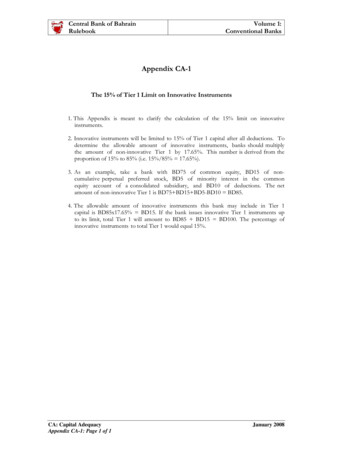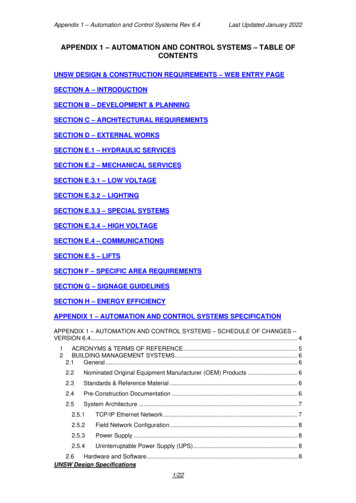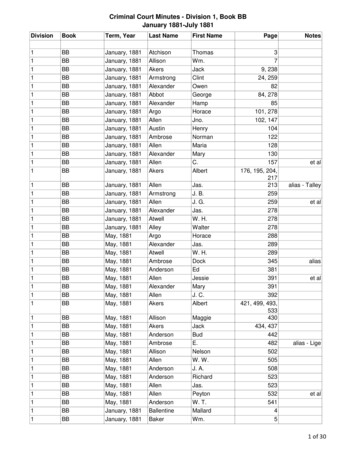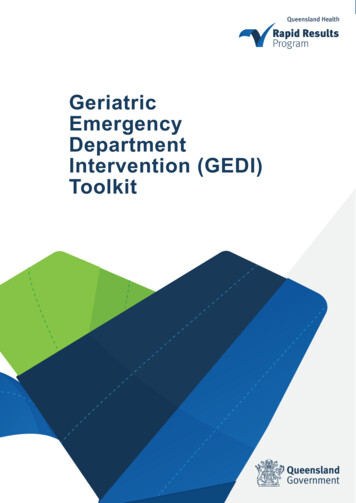
Transcription
Central Bank of BahrainRulebookVolume 1:Conventional BanksAppendix CA-1The 15% of Tier 1 Limit on Innovative Instruments1. This Appendix is meant to clarify the calculation of the 15% limit on innovativeinstruments.2. Innovative instruments will be limited to 15% of Tier 1 capital after all deductions. Todetermine the allowable amount of innovative instruments, banks should multiplythe amount of non-innovative Tier 1 by 17.65%. This number is derived from theproportion of 15% to 85% (i.e. 15%/85% 17.65%).3. As an example, take a bank with BD75 of common equity, BD15 of noncumulative perpetual preferred stock, BD5 of minority interest in the commonequity account of a consolidated subsidiary, and BD10 of deductions. The netamount of non-innovative Tier 1 is BD75 BD15 BD5-BD10 BD85.4. The allowable amount of innovative instruments this bank may include in Tier 1capital is BD85x17.65% BD15. If the bank issues innovative Tier 1 instruments upto its limit, total Tier 1 will amount to BD85 BD15 BD100. The percentage ofinnovative instruments to total Tier 1 would equal 15%.CA: Capital AdequacyAppendix CA-1: Page 1 of 1January 2008
Central Bank of BahrainRulebookVolume 1:Conventional BanksAppendix CA-2Treatment of counterparty credit risk and cross-product netting1. This rule identifies permissible methods for estimating the Exposure at Default(EAD) or the exposure amount for instruments with counterparty credit risk (CCR)under this Framework.1 Banks may seek CBB’s approval to make use of an internalmodelling method meeting the requirements and specifications identified herein. Asalternatives banks may also use the standardised method or the current exposure method.I.Definitions and general terminology2. This section defines terms that will be used throughout this text.A. General terms Counterparty Credit Risk (CCR) is the risk that the counterparty to atransaction could default before the final s e t t l e m e n tof thetransaction’s cash flows. An economic loss would occur if the transactionsor portfolio of transactions with the counterparty has a positive economicvalue at the time of default. Unlike a firm’s exposure to credit risk through aloan, where the exposure to credit risk is unilateral and only the lending bankfaces the risk of loss, CCR creates a bilateral risk of loss: the market value ofthe transaction can be positive or negative to either counterparty to thetransaction. The market value is uncertain and can vary over time with themovement of underlying market factors.B. Transaction types Long Settlement Transactions are transactions where a counterpartyundertakes to deliver a security, a commodity, or a foreign exchangeamount against cash, other financial instruments, or commodities, or vice versa,at a settlement or delivery date that is contractually specified as more than thelower of the market standard for this particular instrument and five business daysafter the date on which the bank enters into the transaction. Securities Financing Transactions (SFTs) are transactions such asrepurchase agreements, reverse repurchase agreements, security lending andborrowing, and margin lending transactions, where the value of the transactionsdepends on market valuations and the transactions are often subject to marginagreements. Margin Lending Transactions are transactions in which a bank extends creditin connection with the purchase, sale, carrying or trading of securities. Marginlending transactions do not include other loans that happen to be securedby securities collateral. Generally, in margin lending transactions, the loan amountis collateralised by securities whose value is greater than the amount of the loan.1In the present document, the terms “exposure at default” and “exposure amount” are used together inorder to identify measures of exposure under both an IRB and a standardised approach for credit risk.CA: Capital AdequacyAppendix CA-2: Page 1 of 24January 2008
Central Bank of BahrainRulebookVolume 1:Conventional BanksC. Netting sets, hedging sets, and related terms Netting Set is a group of transactions with a single counterparty that are subjectto a legally enforceable bilateral netting arrangement and for whichnetting is recognised for regulatory capital purposes under the provisions of the1988 Accord, as amended, this Framework text on credit risk mitigationtechniques, or the Cross- Product Netting Rules set forth in this Appendix. Eachtransaction that is not subject to a legally enforceable bilateral nettingarrangement that is recognised for regulatory capital purposes should beinterpreted as its own netting set for the purpose of these rules. Risk Position is a risk number that is assigned to a transaction under theCCR standardised method (set out in this Appendix) using a regulatoryalgorithm. Hedging Set is a group of risk positions from the transactions within a singlenetting set for which only their balance is relevant for determining theexposure amount or EAD under the CCR standardised method. Margin Agreement is a contractual agreement or provisions to an agreementunder which one counterparty must supply collateral to a secondcounterparty when an exposure of that second counterparty to the firstcounterparty exceeds a specified level. Margin Threshold is the largest amount of an exposure that remainsoutstanding until one party has the right to call for collateral. Margin Period of Risk is the time period from the last exchange ofcollateral covering a netting set of transactions with a defaultingcounterpart until that counterpart is closed out and the resulting market risk isre-hedged. Effective Maturity under the Internal Model Method for a netting set withmaturity greater than one year is the ratio of the sum of expected exposureover the life of the transactions in a netting set discounted at the risk-free rateof return divided by the sum of expected exposure over one year in a nettingset discounted at the risk- free rate. This effective maturity may be adjusted toreflect rollover risk by replacing expected exposure with effective expectedexposure for forecasting horizons under one year. The formula is given later insection V. Cross-Product Netting refers to the inclusion of transactions of differentproduct categories within the same netting set pursuant to the Cross-ProductNetting Rules set out in this Appendix. Current Market Value (CMV) refers to the net market value of theportfolio of transactions within the netting set with the counterparty. Bothpositive and negative market values are used in computing CMV.D. Distributions Distribution of Market Values is the forecast of the probability distributionof net market values of transactions within a netting set for somefuture date (the forecasting horizon) given the realised market value of thosetransactions up to the present time.CA: Capital AdequacyAppendix CA-2: Page 2 of 24January 2008
Central Bank of BahrainRulebookVolume 1:Conventional Banks Distribution of Exposures is the forecast of the probability distribution ofmarket values that is generated by setting forecast instances of negative netmarket values equal to zero (this takes account of the fact that, whenthe bank owes the counterparty money, the bank does not have an exposureto the counterparty). Risk-Neutral Distribution is a distribution of market values or exposures at afuture time period where the distribution is calculated using market impliedvalues such as implied volatilities. Actual Distribution is a distribution of market values or exposures at afuture time period where the distribution is calculated using historic orrealised values such as volatilities calculated using past price or rate changes.E. Exposure measures and adjustments Current Exposure is the larger of zero, or the market value of atransaction or portfolio of transactions within a netting set with acounterparty that would be lost upon the default of the counterparty,assuming no recovery on the value of those transactions in bankruptcy.Current exposure is often also called Replacement Cost. Peak Exposure is a high percentile (typically 95% or 99%) of thedistribution of exposures at any particular future date before the maturitydate of the longest transaction in the netting set. A peak exposure value istypically generated for many future dates up until the longest maturity date oftransactions in the netting set. Expected Exposure is the mean (average) of the distribution of exposuresat any particular future date before the longest-maturity transaction in thenetting set matures. An expected exposure value is typically generated formany future dates up until the longest maturity date of transactions in thenetting set. Effective Expected Exposure at a specific date is the maximumexpected exposure that occurs at that date or any prior date. Alternatively, itmay be defined for a specific date as the greater of the expected exposureat that date, or the effective exposure at the previous date. In effect, theEffective Expected Exposure is the Expected Exposure that is constrained tobe non-decreasing over time. Expected Positive Exposure (EPE) is the weighted average over time ofexpected exposures where the weights are the proportion that anindividual expected exposure represents of the entire time interval. Whencalculating the minimum capital requirement, the average is taken over thefirst year or, if all the contracts in the netting set mature before one year, overthe time period of the longest-maturity contract in the netting set. Effective Expected Positive Exposure (Effective EPE) is the weightedaverage over time of effective expected exposure over the first year, or, if allthe contracts in the netting set mature before one year, over the time periodof the longest-maturity contract in the netting set where the weights are theproportion that an individual expected exposure represents of the entire timeinterval.CA: Capital AdequacyAppendix CA-2: Page 3 of 24January 2008
Central Bank of BahrainRulebookVolume 1:Conventional Banks Credit Valuation Adjustment is an adjustment to the mid-market valuationof the portfolio of trades with a counterparty. This adjustment reflects themarket value of the credit risk due to any failure to perform oncontractual agreements with a counterparty. This adjustment may reflect themarket value of the credit risk of the counterparty or the market value ofthe credit risk of both the bank and the counterparty. One-Sided Credit Valuation Adjustment is a credit valuation adjustmentthat reflects the market value of the credit risk of the counterparty to thefirm, but does not reflect the market value of the credit risk of the bank to thecounterparty.F. CCR-related risksII. Rollover Risk is the amount by which expected positive exposure isunderstated when future transactions with a counterpart are expected to beconducted on an ongoing basis, but the additional exposure generated by thosefuture transactions is not included in calculation of expected positive exposure. General Wrong-Way Risk arises when the probability of default ofcounterparties is positively correlated with general market risk factors. Specific Wrong-Way Risk arises when the exposure to a particularcounterpart is positively correlated with the probability of default of thecounterparty due to the nature of the transactions with the counterparty.Scope of application3. The methods for computing the exposure amount under the standardised approach forcredit risk or EAD under the internal ratings-based (IRB) approach to credit riskdescribed in this Appendix are applicable to SFTs and OTC derivatives.4. Such instruments generally exhibit the following abstract characteristics: The transactions generate a current exposure or market value. The transactions have an associated random future market value based onmarket variables. The transactions generate an exchange of payments or an exchange of afinancial instrument (including commodities) against payment. The transactions are undertaken with an identified counterparty againstwhich a unique probability of default can be determined25. Other common characteristics of the transactions to be covered may include thefollowing: Collateral may be used to mitigate risk exposure and is inherent in thenature of some transactions.2Transactions for which the probability of default is defined on a pooled basis are not included in thistreatment of CCRCA: Capital AdequacyAppendix CA-2: Page 4 of 24January 2008
Central Bank of BahrainRulebookVolume 1:Conventional Banks Short-term financing may be a primary objective in that the transactionsmostly consist of an exchange of one asset for another (cash or securities) for arelatively short period of time, usually for the business purpose of financing.The two sides of the transactions are not the result of separate decisionsbut form an indivisible whole to accomplish a defined objective. Netting may be used to mitigate the risk. Positions are frequently valued (most commonly on a daily basis),according to market variables. Re-margining may be employed.6. An exposure value of zero for counterparty credit risk can be attributed to derivativecontracts or SFTs that are outstanding with a central counterparty (e.g. a clearinghouse). This does not apply to counterparty credit risk exposures from derivativetransactions and SFTs that have been rejected by the central counterparty. Furthermore,an exposure value of zero can be attributed to banks’ credit risk exposures to centralcounterparties that result from the derivative transactions, SFTs or spot transactionsthat the bank has outstanding with the central counterparty. This exemption extends inparticular to credit exposures from clearing deposits and from collateral postedwith the central counterparty. A central counterparty is an entity that interposesitself between counterparties to contracts traded within one or more financialmarkets, becoming the legal counterparty such that it is the buyer to every sellerand the seller to every buyer. In order to qualify for the above exemptions, thecentral counterparty CCR exposures with all participants in its arrangements must befully collateralized on a daily basis, thereby providing protection for the centralcounterparty’s CCR exposures. Assets held by a central counterparty as a custodian onthe bank’s behalf would not be subject to a capital requirement for counterpartycredit risk exposure.7. Under all of the three methods identified in this Appendix, when a bank purchasescredit derivative protection against a banking book exposure, or against a counterpartycredit risk exposure, it will determine its capital requirement for the hedged exposuresubject to the criteria and general rules for the recognition of credit derivatives, i.e.substitution or double default rules as appropriate. Where these rules apply, theexposure amount or EAD for counterparty credit risk from such instruments is zero.8. The exposure amount or EAD for counterparty credit risk is zero for sold creditdefault swaps in the banking book where they are treated in the framework as aguarantee provided by the bank and subject to a credit risk charge for the full notionalamount.9. Under all three methods identified in this Appendix, the exposure amount or EAD for agiven counterparty is equal to the sum of the exposure amounts or EADs calculated foreach netting set with that counterparty.CA: Capital AdequacyAppendix CA-2: Page 5 of 24January 2008
Central Bank of BahrainRulebookIII.Volume 1:Conventional BanksCross-product netting rules310. Banks that receive approval to estimate their exposures to CCR using the internal modelmethod may include within a netting set SFTs, or both SFTs and OTCderivatives subject to a legally valid form of bilateral netting that satisfies thefollowing legal and operational criteria for a Cross-Product Netting Arrangement (asdefined below). The bank must also have satisfied any prior approval or otherprocedural requirements that CBB determines to implement for purposes of recognisinga Cross-Product Netting Arrangement.Legal Criteria11. The bank has executed a written, bilateral netting agreement with the counterparty thatcreates a single legal obligation, covering all included bilateral master agreements andtransactions (“Cross-Product Netting Arrangement”), such that the bank would haveeither a claim to receive or obligation to pay only the net sum of the positive andnegative (i) close- out values of any included individual master agreements and (ii)mark-to-market values of any included individual transactions (the “Cross-ProductNet Amount”), in the event a counterparty fails to perform due to any of thefollowing: default, bankruptcy, liquidation or similar circumstances.12. The bank has written and reasoned legal opinions that conclude with a high degree ofcertainty that, in the event of a legal challenge, relevant courts or administrativeauthorities would find the firm’s exposure under the Cross-Product NettingArrangement to be the Cross-Product Net Amount under the laws of all relevantjurisdictions. In reaching this conclusion, legal opinions must address the validity andenforceability of the entire Cross- Product Netting Arrangement under its terms andthe impact of the Cross-Product Netting Arrangement on the material provisions ofany included bilateral master agreement. The laws of “all relevant jurisdictions” are: (i) the law of the jurisdiction inwhich the counterparty is chartered and, if the foreign branch of acounterparty is involved, then also under the law of the jurisdiction in whichthe branch is located, (ii) the law that governs the individual transactions, and(iii) the law that governs any contract or agreement necessary to effect thenetting. A legal opinion must be generally recognised as such by the legal community inthe firm’s home country or a memorandum of law that addresses all relevantissues in a reasoned manner.13. The bank has internal procedures to verify that, prior to including a transaction innetting set; the transaction is covered by legal opinions that meet the above criteria.14. The bank undertakes to update legal opinions as necessary to ensure continuingenforceability of the Cross-Product Netting Arrangement in light of possiblechanges in relevant law.These Cross-Product Netting Rules apply specifically to netting across SFTs, or to netting across both SFTs and OTC derivatives, forpurposes of regulatory capital computation under IMM. They do not revise or replace the rules that apply to recognition of nettingwithin the OTC derivatives, repo-style transaction, and margin lending transaction product categories under the 1988 Accord, asamended, or in this Framework. The rules in the 1988 Accord and this Framework continue to apply for purposes of regulatory capitalrecognition of netting within product categories under IMM or other relevant methodology3CA: Capital AdequacyAppendix CA-2: Page 6 of 24January 2008
Central Bank of BahrainRulebookVolume 1:Conventional Banks15. The Cross-Product Netting Arrangement does not include a walkaway clause. Awalkaway clause is a provision which permits a non-defaulting counterparty tomake only limited payments, or no payment at all, to the estate of the defaulter, even ifthe defaulter is a net creditor.16. Each included bilateral master agreement and transaction included in the CrossProduct Netting Arrangement satisfies applicable legal requirements forrecognition of (i) bilateral netting of derivatives contracts in Appendix 3 of the 1988Accord, as amended in April 1995, or (ii) credit risk mitigation techniques in Part 2,Section II.D of this framework.17. The bank maintains all required documentation in its files.Operational Criteria18. The CBB authority is satisfied that the effects of a Cross-Product NettingArrangement are factored into the firm’s measurement of a counterparty’s aggregatecredit risk exposure and that the bank manages its counterparty credit risk on such basis.19. Credit risk to each counterparty is aggregated to arrive at a single legal exposureacross products covered by the Cross-Product Netting Arrangement. This aggregationmust be factored into credit limit and economic capital processes.IV. Approval to adopt an internal modelling method to estimate EAD20. A bank (meaning the individual legal entity or a group) that wishes to adopt aninternal modelling method to measure exposure or EAD for regulatory capitalpurposes must seek approval from the CBB. The internal modelling method isavailable both for banks that adopt the internal ratings-based approach to credit riskand for banks for which the standardised approach to credit risk applies to all oftheir credit risk exposures. The bank must meet all of the requirements given inSection V of this Appendix and must apply the method to all of its exposures thatare subject to counterparty credit risk, except for long settlement transactions.21. A bank may also choose to adopt an internal modelling method to measure CCR forregulatory capital purposes for its exposures or EAD to only OTC derivatives, to onlySFTs, or to both, subject to the appropriate recognition of netting specified above.The bank must apply the method to all relevant exposures within that category,except for those that are immaterial in size and risk. During the initial implementationof the internal models method, a bank may use the standardised method or thecurrent exposure method for a portion of its business. The bank must submit a planto CBB to bring all material exposures for that category of transactions under theinternal model method.22. For all OTC derivative transactions and for all long settlement transactions for which abank has not received approval from the CBB to use the internal models method, thebank must use either the standardised method or the current exposure method.Combined use of the current exposure method and the standardised method ispermitted on a permanent basis within a group. Combined use of the currentexposure method and the standardised method within a legal entity is onlypermissible for the cases indicated in section VI. of this Appendix.CA: Capital AdequacyAppendix CA-2: Page 7 of 24January 2008
Central Bank of BahrainRulebookVolume 1:Conventional Banks23. Exposures or EAD arising from long settlement transactions can be determinedusing any of the three methods identified in this document regardless of the methodschosen for treating OTC derivatives and SFTs. In computing capital requirements forlong settlement transactions banks that hold permission to use the internal ratings-basedapproach may opt to apply the risk weights under this Framework’s standardisedapproach for credit risk on a permanent basis and irrespective to the materiality of suchpositions.24. After adoption of the internal model method, the bank must comply with the aboverequirements on a permanent basis. Only under exceptional circumstances or forimmaterial exposures can a bank revert to either the current exposure or standardisedmethods for all or part of its exposure. The bank must demonstrate that reversion to a lesssophisticated method does not lead to an arbitrage of the regulatory capital rules.V.Internal Model Method: measuring exposure and minimumrequirementsA.Exposure amount or EAD under the internal model method25. CCR exposure or EAD is measured at the level of the netting set as defined inSections I and III of this Appendix. A qualifying internal model for measuringcounterparty credit exposure must specify the forecasting distribution for changes inthe market value of the netting set attributable to changes in market variables,such as interest rates, foreign exchange rates, etc. The model then computes the firm’sCCR exposure for the netting set at each future date given the changes in the marketvariables. For margined counterparties, the model may also capture future collateralmovements. Banks may include eligible financial collateral as defined in CA-4.3.2and CA-8.3 of this Framework in their forecasting distributions for changes in themarket value of the netting set, if the quantitative, qualitative and data requirements forinternal model method are met for the collateral.26. To the extent that a bank recognises collateral in exposure amount or EAD viacurrent exposure, a bank would not be permitted to recognise the benefits in itsestimates of LGD. As a result, the bank would be required to use an LGD of anotherwise similar un-collateralised facility. In other words, the bank would be requiredto use an LGD that does not include collateral that is already included in EAD.27. Under the Internal Model Method, the bank need not employ a single model.Although the following text describes an internal model as a simulation model, noparticular form of model is required. Analytical models are acceptable so long as theyare subject to CBB review, meet all of the requirements set forth in this section and areapplied to all material exposures subject to a CCR-related capital charge as notedabove, with the exception of long settlement transactions, which are treatedseparately, and with the exception of those exposures that are immaterial in size andrisk.28. Expected exposure or peak exposure measures should be calculated based on adistribution of exposures that accounts for the possible non-normality of thedistribution of exposures, including the existence of leptokurtosis (“fat tails”), whereappropriate.CA: Capital AdequacyAppendix CA-2: Page 8 of 24January 2008
Central Bank of BahrainRulebookVolume 1:Conventional Banks29. When using an internal model, exposure amount or EAD is calculated as theproduct of alpha times Effective EPE, as specified below:EAD α x Effective EPE(1)30. Effective EPE (“Expected Positive Exposure”) is computed by estimating expectedexposure (EEt) as the average exposure at future date t, where the average is takenacross possible future values of relevant market risk factors, such as interestrates, foreign exchange rates, etc. The internal model estimates EE at a series of futuredates t1, t2, t3 4 , Specifically, “Effective EE” is computed recursively asEffective EEtk max(Effective EEtk-1 , EEtk) (2)where the current date is denoted as t0 and Effective EEt0 equals current exposure.31. In this regard, “Effective EPE” is the average Effective EE during the first yearof future exposure. If all contracts in the netting set mature before one year, EPE is theaverage of expected exposure until all contracts in the netting set mature. Effective EPEis computed as a weighted average of Effective EE:Min. (1year, maturity)Effective EPE Effective EE tk X tk (3)K 1Where the weights tk tk – tk-1 allows for the case when future exposure is calculatedat dates that are not equally spaced over time.32. Alpha (α) is set equal to 1.4.33. CBB has the discretion to require a higher alpha based on a firm’s CCR exposures.Factors that may require a higher alpha include the low granularity of counterparties;particularly high exposures to general wrong-way risk; particularly high correlation ofmarket values across counterparties; and other institution-specific characteristics of CCRexposures.B. Own estimates for alpha34. Banks may seek approval from the CBB to compute internal estimates of alphasubject to a floor of 1.2, where alpha equals the ratio of economic capital from a fullsimulation of counterparty exposure across counterparties (numerator) and economiccapital based on EPE (denominator), assuming they meet certain operating requirements.Eligible banks must meet all the operating requirements for internal estimates ofEPE and must demonstrate that their internal estimates of alpha capture in thenumerator the material sources of stochastic dependency of distributions of market valuesof transactions or of portfolios of transactions across counterparties (e.g. the correlationof defaults across counterparties and between market risk and default).35. In the denominator, EPE must be used as if it were a fixed outstanding loan amount.4In theory, the expectations should be taken with respect to the actual probability distribution of future exposure and not the risk-neutralone. CBB recognises that practical considerations may make it more feasible to use the risk-neutral one. As a result, CBB will notmandate which kind of forecasting distribution to employCA: Capital AdequacyAppendix CA-2: Page 9 of 24January 2008
Central Bank of BahrainRulebookVolume 1:Conventional Banks36. To this end, banks must ensure that the numerator and denominator of alpha arecomputed in a consistent fashion with respect to the modelling methodology,parameter specifications and portfolio composition. The approach used must bebased on the firm’s internal economic capital approach, be well-documented andbe subject to independent validation. In addition, banks must review their estimates onat least a quarterly basis, and more frequently when the composition of the portfoliovaries over time. Banks must assess the model risk.37. Where appropriate, volatilities and correlations of market risk factors used in thejoint simulation of market and credit risk should be conditioned on the creditrisk factor to reflect potential increases in volatility or correlation in an economicdownturn. Internal estimates of alpha should take account of the granularity ofexposures.C. Maturity38. If the original maturity of the longest-dated contract contained in the set is greater thanone year, the formula for effective maturity (M) in CA-5.3.50 of this Framework isreplaced with the following:tk 1yearmaturity Effective EEk X t k X dfk EEk X t k X dfkk 1M tk 1year Effective EEk X t k X dfkk 1Where dfk is the risk-free discount factor for future time period tk and the remaining sSymbols are defined above. Similar to the treatment under corporate exposures, M has acap of five years5.39. For netting sets in which all contracts have an original maturity of less than oneyear, the form
This adjustment may reflect the market value of the credit risk of the counterparty or the market value of the credit risk of both the bank and the counterparty. One-Sided Credit Valuation Adjustment is a credit valuation adjustment that reflects the market value of the credit risk of the counterparty to the firm, but does not reflect the .











